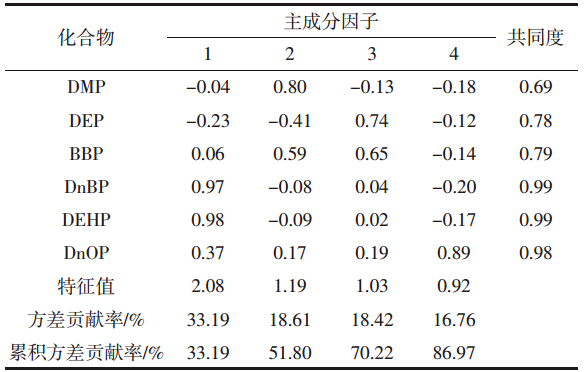文章信息
- 徐雪, 王利军, 卢新卫
- XU Xue, WANG Li-jun, LU Xin-wei
- 咸阳市郊菜地土壤中邻苯二甲酸酯(PAEs)污染研究
- Pollution of Phthalic Acid Esters(PAEs) in Vegetable Soils in Xianyang Suburbs, Northwest China
- 农业环境科学学报, 2014, 33(10): 1912-1919
- Journal of Agro-Environment Science, 2014, 33(10): 1912-1919
- http://dx.doi.org/10.11654/jaes.2014.10.006
-
文章历史
- 收稿日期:2014-4-7
邻苯二甲酸酯(Phthalic acid esters,PAEs)是一类人工合成的、工业上广泛使用的有机化合物,主要用作塑料的增塑剂和软化剂来增大产品的可塑性和提高产品的强度,也可用作农药、涂料和化妆品等生产原料,在家具、玩具和服装等行业也广泛应用[1,2,3].由于PAEs水溶性较低,具有较大的辛醇-水分配系数(Kow),对动植物体具有很强的亲和力,易在生物体和环境中累积[4,5].研究资料表明,PAEs具有致癌、致畸、致突变“三致”效应[6],还能干扰人类及其他动物体内血液中激素的正常水平和内分泌活动,进而影响生殖健康,是一类重要的环境激素类物质[7,8,9].目前,PAEs危害已经引起各国政府及相关组织的高度关注,美国环境保护部(US EPA)将6种PAEs列为优先控制污染物,世界野生动物基金会(WWF)列出的68种环境激素类物质中包括8种PAEs,我国也将3种PAEs列入优先控制污染物。
由于PAEs的广泛使用,PAEs在土壤[10,11,12]、水体[13,14,15]、大气[16,17]、沉积物[18,19]等环境介质中普遍存在。土壤是人类重要的资源之一,是发展农业生产的物质基础,为作物生长提供介质和供应养分[20].由于PAEs 容易富集在土壤中被农作物和蔬菜吸收至可食用部分而污染食物链[21,22,23],农业土壤中PAEs污染已成为国内外关注的热点问题。国外对荷兰、丹麦等土壤中PAEs污染进行了研究[13,24].近年来,国内对广东、北京、天津、台州、邯郸及哈尔滨等地区农业土壤及城市土壤中PAEs污染相继开展了研究[25,26,27,28,29].然而,有关关中地区土壤中PAEs的污染研究还鲜有报道。
蔬菜种植基地是城市居民新鲜蔬菜和农作物主要供应地,往往地处城乡结合部,受城市化、工业化及农业现代化影响严重[30].咸阳市位于陕西中部,蔬菜种植面积占全省四分之一,辖区泾阳县云阳镇、三原县鲁桥镇、兴平市马嵬镇以及城郊(尤其是东南郊、西南郊及南郊)均有蔬菜种植基地,为城市居民提供新鲜蔬菜供给。本文以咸阳市郊菜地土壤为研究对象,研究菜地土壤中US EPA优控6种邻苯二甲酸酯(PAEs)的含量水平、构成特征、分布特征,环境来源及污染水平,对保证农产品质量和居民健康具有重要意义。 1 材料与方法 1.1 样品采集及预处理
在实际调研的基础上,在咸阳市东南郊、西南郊及南郊选择4个代表性菜地(蔬菜种植20~40年,种植过程中均有使用地膜、大棚栽培和化肥的历史),布设土壤样品采样点(图 1),即:曹家寨(n=27)、东张村(n=12)、郭村(n=4)和八兴滩(n=16).在每个采样点采集4份土壤样品(在2 m×2 m方格四个顶点,采样深度为0~25 cm),现场利用四分法缩分至约0.5 kg,装入棕色广口瓶。采集好的土壤样品在室温条件下自然风干,破碎、研磨过100目不锈钢筛,贮存于棕色广口瓶,在4 ℃冷藏待提取。
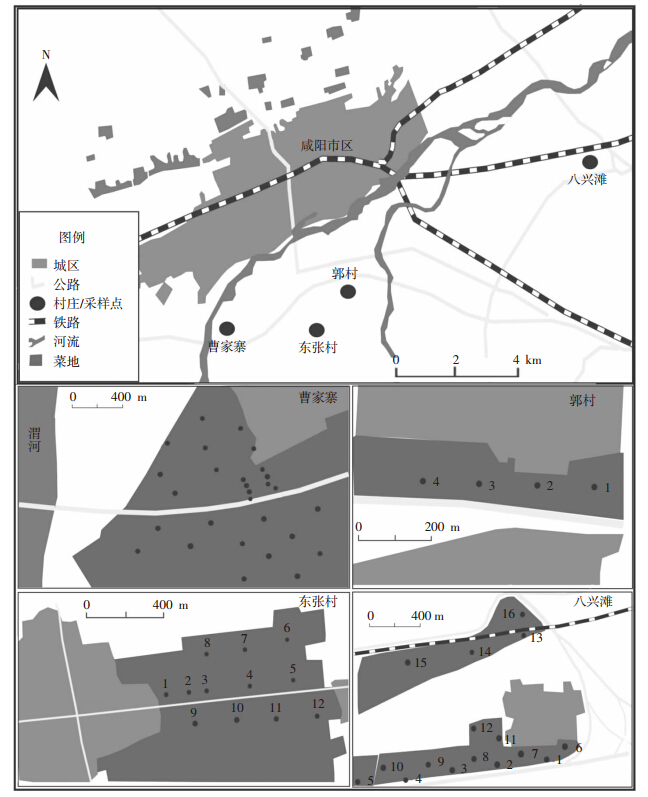
|
| 图 1 土壤采样点示意图 Figure 1 Schematic map of soil sampling sites |
美国戴安Ultimate-3000型液相色谱仪,带二极管阵列检测器(DAD);大连依利特Hypersil ODS2液相色谱柱(4.6 mm×250 mm,5 μm);索氏提取器;上海亚荣生化仪器厂RE-52A型旋转蒸发仪;ABSON公司NAS-12型氮吹仪;玻璃层析柱(1 cm×30 cm).
正己烷、丙酮、二氯甲烷、甲醇和乙腈均为色谱纯,购自美国J.T. Baker公司;层析硅胶(80~100目,青岛海洋化工厂)和层析氧化铝(100~200目,国药集团化学试剂有限公司),使用前分别在180 ℃和250 ℃活化6 h和12 h.无水硫酸钠(分析纯,天津市化学试剂厂),使用前在450 ℃马弗炉中灼烧6 h;PAEs混合标准溶液,含邻苯二甲酸二甲酯(DMP)、邻苯二甲酸二乙酯(DEP)、邻苯二甲酸正二丁酯(DnBP)、邻苯二甲酸苄基丁基酯(BBP)、邻苯二甲酸二(2-乙基己基)酯(DEHP)和邻苯二甲酸正二辛酯(DnOP),浓度均为2000 μg·mL-1,甲醇介质,购自美国Supelco公司,用甲醇稀释,配成标准梯度。 1.3 PAEs提取与净化
称取15 g土壤样品和5 g无水硫酸钠,混合均匀,用滤纸(用二氯甲烷索氏抽提48 h)包好,置于索氏提取管中,用200 mL正己烷和丙酮混合溶液(1∶1,V/V)索氏抽提24 h.提取温度不超过60 ℃,回流速度控制在4~6次·h-1.提取液旋转蒸发浓缩至1~2 mL,加入20 mL正己烷,继续旋转蒸发浓缩至 1~2 mL,完成溶剂转换,过硅胶/氧化铝层析柱净化。
硅胶/氧化铝层析柱,自下而上依次为6 cm氧化铝、12 cm硅胶和1 cm无水硫酸钠,正己烷平衡后装样,用20 mL正己烷、70 mL 二氯甲烷和正己烷混合溶液(3∶7,V/V)和40 mL丙酮和正己烷混合溶液(2∶8,V/V)分别淋洗脂肪烃、芳烃和酯。收集含酯淋洗液,旋转蒸发浓缩至1~2 mL,转移至氮吹管,在N2氛围下吹干,用甲醇溶解定容到1.5 mL. 1.4 仪器分析
标准梯度和样品中PAEs利用美国戴安液相色谱和大连依利特液相色谱柱进行分离。淋洗液采用CH3CN(A)和H2O(B),流速为1.0 mL·min-1,梯度程序为0~4 min,A保持60%,4~5 min,A由60%增加到70%,5~11 min,A保持70%,11~14 min,A由60%增加到100%,14~22 min,A保持100%.柱温箱为30 ℃,检测波长采用225 nm,进样量为20 μL.样品中PAEs化合物采用保留时间进行定性,利用标准曲线进行定量。 1.5 质量控制
实验过程中严格禁止使用各种塑料器皿。所有玻璃器皿均在重铬酸钾洗液中浸泡过夜,分别用自来水、蒸馏水和超纯水清洗3次并烘干,使用前用相应有机溶剂润洗。取所用有机试剂3 mL于氮吹管中,在N2氛围下吹干,用甲醇溶解并定容1.5 mL,均未检测到目标物。过程空白试验结果表明,仅有少量DMP和DEP检出,分别为2 μg·L-1和3 μg·L-1.以3倍信噪比计算仪器的检出限可知,DMP、DEP、BBP、DnBP、DEHP和DnOP的检出限分别为13、28、6、71、15、11 μg·L-1.回收率试验(加入一定量的标准混合溶液)结果表明,方法的回收率在80%~103%(除了DEHP为73%).同时,对10%的样品进行重复试验,结果的重现性(以相对标准偏差RSD表示)在8%以内。 2 结果与讨论 2.1 土壤中PAEs含量与分布
表 1是咸阳市郊菜地土壤中US EPA优控6种邻苯二甲酸酯(PAEs)的含量。由表 1可知,咸阳市郊菜地土壤中DMP、DEP、BBP、DnBP、DEHP和DnOP的含量范围从未检出~6 313.35 μg·kg-1,其平均含量分别为54.39、19.62、39.52、314.17、163.25 μg·kg-1和41.15 μg·kg-1,检出率分别为100%、52%、80%、100%、98%和63%,含量高低顺序为DnBP>DEHP>DMP>DnOP>BBP>DEP.6种PAEs总含量范围在128.60~10 288.42 μg·kg-1,平均为632.10 μg·kg-1.
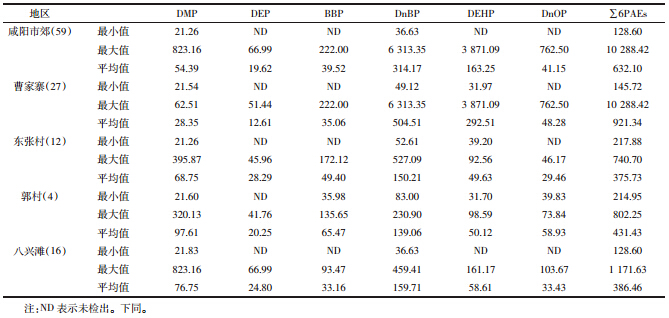 |
表 2是对咸阳市郊菜地土壤和其他地区土壤中PAEs含量进行比较。由表 2可知,新疆棉田土壤中PAEs含量最高,其次是城市土壤,农业土壤较低。这可能是由于新疆地区气候寒冷、干旱,在农业生产中大量使用地膜,同时,城市土壤受当地工农业生产活动影响较一般农业土壤强烈。与广州、北京城市土壤中PAEs含量比较可知,咸阳市郊菜地中DnBP、DEHP及∑6PAEs含量相对较低,DMP、DEP、BBP和DnOP处于中等水平。与其他地区农用土壤中PAEs含量进行比较可知,咸阳市郊菜地土壤中DMP和DEHP含量属于中等水平,其他化合物则处于较低水平,6种PAEs总含量高于惠州,与广东和天津的部分地区一致,低于其他地区。总体而言,咸阳市郊菜地土壤中PAEs的含量处于中等水平,可能与地区经济发展水平和当地人类活动强度有关[27].
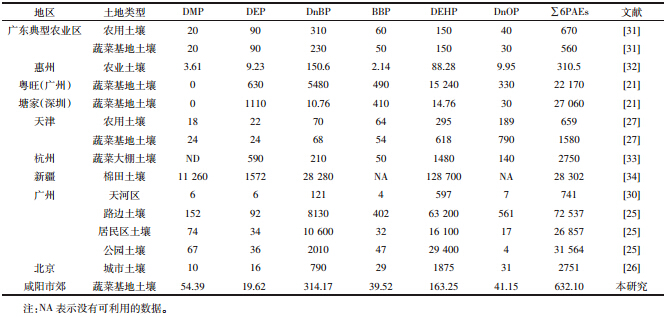 |
从不同菜地土壤中单个PAEs含量看,DMP和DEP的最高含量均在八兴滩,BBP、DnBP、DEHP和DnOP的最高含量均在曹家寨;DMP在不同菜地土壤中的平均含量顺序为郭村>八兴滩>东张村>曹家寨;DEP的顺序为东张村>八兴滩>郭村>曹家寨;BBP的顺序为郭村>东张村>曹家寨>八兴滩;DnBP和DEHP的顺序均为曹家寨>八兴滩>东张村和郭村;DnOP的顺序为郭村>曹家寨>八兴滩>东张村。从不同菜地土壤中6种PAEs的总量来看,∑6PAEs在不同菜地土壤中的含量顺序为曹家寨>郭村>八兴滩>东张村。从土壤中PAEs的分布可以看出,曹家寨菜地土壤中PAEs含量水平相对较高。 2.2 土壤中PAEs构成
图 2为单个PAEs在土壤中所占的百分比。由图 2可知,咸阳市郊菜地土壤中PAEs主要以DnBP 和 DEHP 为主,二者约占∑6PAEs的76%.这与苏南地区[35]、雷州半岛[36]和天津郊区[27]等地土壤中PAEs研究结果相似。曹家寨、东张村和八兴滩三块菜地土壤也都主要以DnBP 和 DEHP 为主,DnBP占∑6PAEs的40%~55%,DEHP占∑6PAEs的13%~32%,郭村则主要以DnBP 和DMP为主,分别占∑6PAEs的32%和23%.土壤中PAEs的构成差异,可能与PAEs的理化性质、环境来源以及土壤的理化性质和环境条件有关[37].由于DnBP和DEHP等分子量相对较大,水溶性相对较低,辛醇-水分配系数相对较大,易被土壤吸附并富集,不易被生物降解或通过其他途径消失,在土壤中含量较高[38,39].然而,DMP和DEP等短链PAEs的水溶性相对较高,辛醇-水分配系数相对较小,易被生物降解,一般土壤中的含量相对较低[39].
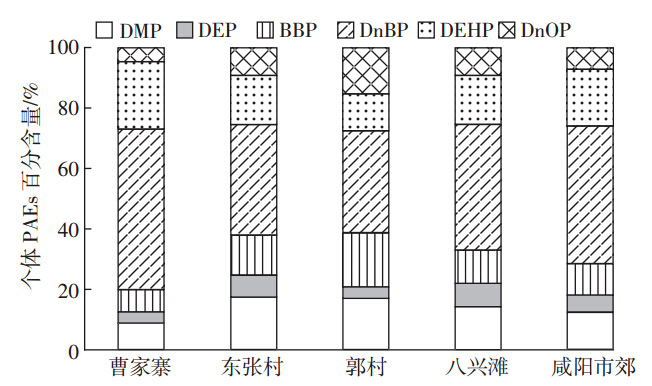
|
| 图 2 咸阳郊区蔬菜基地表层土壤PAEs分布特征 Figure 2 Composition of PAEs in vegetable soils from Xianyang suburbs |
土壤中PAEs主成分分析结果见表 3.主成分分析从土壤PAEs中提取了4个主因子,特征值分别为2.08、1.19、1.03和0.92,其累积方差贡献率为86.97%.因子1主要由DnBP(0.97)与DEHP(0.98)构成,此外还有小部分的DnOP(0.37),方差贡献率为33.19%;因子2由DMP(0.80)与部分BBP(0.59)构成,方差贡献率为18.61%;因子3主要由DEP(0.74)与BBP(0.65)构成,方差贡献率为18.42%;因子4主要是DnOP(0.89),方差贡献率为16.76%.
图 3是土壤PAEs聚类结果。由图 3可知,聚类分析将土壤中PAEs分为4类:DnBP和DEHP为类1,DMP和BBP为类2,DnOP和DEP分别为类3和类4,与主成分分析结果一致。其中,类2、类3和类4在更高水平上构成一类,反映它们可能有相同的环境来源或环境行为。
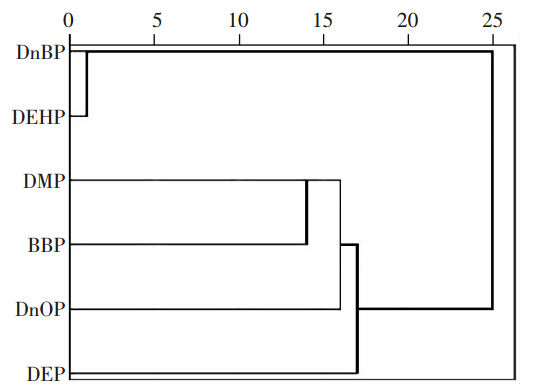
|
| 图 3 土壤PAEs聚类分析结果 Figure 3 Results of cluster analysis of PAEs in soils |
PAEs占增塑剂市场的80%,在聚体中的含量高达10%~60%[30],最常用的是DnBP和DEHP,长链DnOP也是增塑剂中经常使用的化合物。地膜是重要的农业生产物资之一,具有保温保湿作用,尤其是在干旱、寒冷地区。我国是地膜栽培大国,陕西是主要的使用省份之一。然而,PAEs在塑料及其他相关制品中与聚烯烃类塑料分子之间并非共价键结合,而是由氢键和范德华力连接,彼此保留各自相对独立的化学性质,在生产、使用和处置过程中,随着时间的推移,可由塑料等制品迁移到外界环境[1].研究区域四块菜地种植年限在20~40年,种植过程中均使用地膜或大棚栽培,且土壤中PAEs构成表明主要以DnBP和DEHP为主,与DnBP和DEHP是最常使用的增塑剂一致。研究表明[40],土壤中DMP、DEP 和 BBP含量与塑料大棚使用模式没有显着的相关性,而DnBP、DEHP 和 DnOP是不同塑料大棚使用模式主要的PAEs类化合物。因此,类1包含的DnBP和DEHP及部分DnOP主要来自于地膜的使用。
DMP和DEP通常用于个人护理品、化妆品、涂料、特殊粘合剂和环氧树脂等工业产品,BBP和DnOP也被广泛用于乙烯地板的生产、皮革合成、油墨等[30].近几年来咸阳市郊城镇化发展迅速,城郊流动人口密度大、房地产业发达,尤其是郭村一带。在四块菜地之中,郭村菜地土壤中DMP、BBP和DnOP含量水平最高,而且郭村周围存在生活垃圾和建筑垃圾堆放现象。由此可见,个人护理品、化妆品以及建筑行业室内装修材料可能是菜地土壤中DMP和DEP的主要来源,土壤中BBP和DnOP可能主要来源于室内装修材料。这些污染物可以从材料中缓慢释放进入空气或水体,由于这几种化合物属于短链PAEs,水溶性相对较高,往往可通过城市垃圾途径进入土壤。 2.4 土壤中PAEs污染分析
目前,我国还没有土壤PAEs污染方面的相关标准,本文参考美国纽约州土壤中PAEs 控制和治理标准(表 4)[41]分析了研究区域土壤中PAEs的污染状况。根据美国纽约州土壤PAEs 控制和治理标准,咸阳市郊菜地土壤中DEP、BBP、DEHP和DnOP含量均未超过美国纽约州土壤中PAEs的控制标准。然而,所有土壤样品中DMP含量超过了美国纽约州土壤PAEs控制标准,个别样点甚至超过控制标准40倍,DnBP在85%的土壤样品中含量超过了美国纽约州土壤PAEs控制标准。土壤中DMP和DnBP含量超标的土壤样品在研究区4块菜地中均匀分布,但均未超过美国纽约州土壤PAEs治理标准。
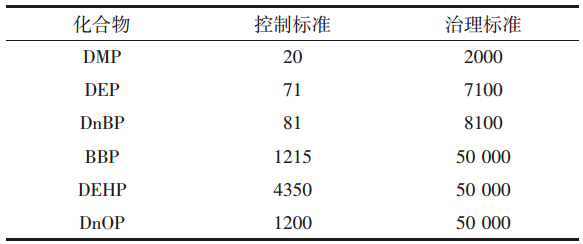 |
(1)咸阳市郊菜地土壤中US EPA优控的6种PAEs均有不同程度的被检出,PAEs总量范围在128.60~10 288.42 μg·kg-1,平均为632.10 μg·kg-1,处于中等水平,主要以DnBP、DEHP和DMP为主,不同菜地土壤中的PAEs总量顺序为曹家寨>郭村>八兴滩>东张村。
(2)咸阳市郊菜地土壤中DEHP和DnBP主要来源于地膜的使用,DMP、DEP、DnOP和BBP可能与个人护理品、化妆品及室内装修材料有关。
(3)咸阳市郊菜地土壤中DMP和DnBP含量不同程度超过了美国纽约州土壤PAEs控制标准,但均未超治理标准。
| [1] | Staples C A, Peterson D R, Parkerton T F, et al. The environmental fate of phthalate esters:A literature review[J]. Chemosphere, 1997, 35(4):667-749. |
| [2] | Abdel daiem M M, Rivera-Utrilla J, Ocampo-Pérez R, et al. Environmental impact of phthalic acid esters and their removal from water and sediments by different technologies:A review[J]. Journal of Environmental Management, 2012, 109:164-178. |
| [3] | Mackintosh C E, Maldonado J, Hongwu J, et al. Distribution of phthalate esters in a marine aquatic food web:Comparison to polychlorinated biph-enyls[J]. Environmental Science & Technology, 2004, 38:2011-2020. |
| [4] | 吴 琼, 刘慧, 张 丹, 等. 邻苯二甲酸酯对浅层含水层沉积物微生物多样性的影响[J]. 中国环境科学, 2010, 30(5):671-676. WU Qiong, LIU Hui, ZHANG Dan, et al. Effect of di-n-butyl phthalate(DBP) on the microbial diversity in shallow aquifer sediment[J]. China Environmental Science, 2010, 30(5):671-676. |
| [5] | 高香玉, 崔益斌, 胡长伟, 等. 太湖梅梁湾2008年有机污染物检测及环境影响度[J]. 中国环境科学, 2009, 29(12):1296-1300. GAO Xiang-yu, CUI Yi-bin, HU Chang-wei, et al. Detection and ambient severity evaluation of organic compounds in Meiliang Bay of Taihu Lake in 2008[J]. China Environmental Science, 2009, 29(12):1296-1300. |
| [6] | Agarwal D K, Lawrence W H, Autian J. Antifertility and mutagenic effects in mice from parenteral administration of DEHP[J]. Journal of Toxicology and Environmental Health, 1985, 16:71-84. |
| [7] | Thompson C J, Ross S M, Gaido K W. Di(n-butyl)phthalate impairs cholesterol transport and steroid genesis in the fetal rat testis through a rapid and reversible mechanism[J]. Endocrinology, 2004, 145:1227-1237. |
| [8] | Swan S H. Environmental phthalate exposure in relation to reproductive outcomes and other health endpoints in humans[J]. Environmental Research, 2008, 108:177-184. |
| [9] | Benson R. Hazard to the developing male reproductive system from cumulative exposure to phthalate esters - dibutyl phthalate, diisobutyl phthalate, butylbenzyl phthalate, diethylhexyl phthalate, dipentyl phthalate, and diisononyl phthalate[J]. Regulatory Toxicology and Pharmacology, 2009, 53:90-101. |
| [10] | Liu H, Liang Y, Zhang D, et al. Impact of MSW landfill on the environmental contamination of phthalate esters[J]. Waste Management, 2010, 30:1569-1576. |
| [11] | Chen L, Zhao Y, Li L, et al. Exposure assessment of phthalates in non-occupational populations in China[J]. Science of the Total Environment, 2012, 427- 428:60-69. |
| [12] | Xu G, Li F S, Wang Q H. Occurrence and degradation characteristics of dibutyl phthalate(DBP) and di-(2-ethylhexyl)phthalate(DEHP) in typical agricultural soils of China[J]. Science of the Total Environment, 2008, 393:333-340. |
| [13] | Peijnenburg W J G M, Struijs J. Occurrence of phthalate esters in the environment of the Netherlands[J]. Ecotoxicology and Environment Safety, 2006, 63:204-215. |
| [14] | Zheng X X, Zhang B T, Teng Y G. Distribution of phthalate acid esters in lakes of Beijing and its relationship with anthropogenic activities[J]. Science of the Total Environment, 2014, 476-477:107-113. |
| [15] | Shi W, Hu X X, Zhang F X, et al. Occurrence of thyroid hormone activities in drinking water from Eastern China:Contributions of phthalate esters[J]. Environmental Science & Technology, 2012, 46:1811-1818. |
| [16] | Teil M J, Blanchard M, Chevreuil M. Atmospheric fate of phthalate esters in an urban area(Paris-France)[J]. Science of the Total Environment, 2006, 354:212-223. |
| [17] | Kong S F, Ji Y Q, Liu L L, et al. Spatial and temporal variation of phthalic acid esters(PAEs) in atmospheric PM10 and PM2.5 and the influence of ambient temperature in Tianjin, China[J]. Atmospheric Environment, 2013, 74:199-208. |
| [18] | Zeng F, Cui K Y, Xie Z Y, et al. Occurrence of phthalate esters in water and sediment of urban lakes in a subtropical city, Guangzhou, South China[J]. Environment International, 2008, 34:372-380. |
| [19] | Liu H, Liang H, Liang Y, et al. Distribution of phthalate esters in alluvial sediment:A case study at Jianghan Plain, Central China[J]. Chemosphere, 2010, 78:382-388. |
| [20] | Chen T B, Wong J W C, Zhou H Y, et al. Assessment of trace metal distribution and contamination in surface soils of Hongkong[J]. Environmental Pollution, 1997, 96(1): 61-68. |
| [21] | 蔡全英, 莫测辉, 李云辉, 等. 广州、深圳地区蔬菜生产基地土壤中邻苯二甲酸酯(PAEs)研究[J]. 生态学报, 2005, 25(2):283-288. CAI Quan-ying, MO Ce-hui, LI Yun-hui, et al. The study of PAEs in soils from typical vegetable fields in areas of Guangzhou and Shenzhen, South China[J]. Acta Ecologica Sinica, 2005, 25(2):283-288. |
| [22] | 蔡全英, 莫测辉, 朱夕珍, 等. 城市污泥对通菜-水稻土中有机污染物的累积效应[J]. 中国环境科学, 2003, 23(3):321-326 . CAI Quan-ying, MO Ce-hui, ZHU Xi-zhen, et al. Effect of municipal sludge on the accumulation of organic pollutants in Ipomoea aquatic plant-paddy soil[J]. China Environmental Science, 2003, 23(3):321-326. |
| [23] | Chi J. Phthalate acid esters in Potamogeton crispus L. from Haihe River, China[J]. Chemosphere, 2009, 77(1):48-52. |
| [24] | VikelsФe J, Thomsen M, Carlsen L. Phthalates and nonylphenols in profiles of differently dressed soils[J]. The Science of the Total Environment, 2002, 296:105-116. |
| [25] | Zeng F, Cui K Y, Xie Z Y, et al. Distribution of phthalate esters in urban soils of subtropical city, Guangzhou, China[J]. Journal of Hazardous Materials, 2009, 164:1171-1178. |
| [26] | Li X H, Ma L L, Liu X F, et al. Phthalate ester pollution in urban soil of Beijing, China[J]. Bulletin of Environmental Contamination and Toxicology, 2006, 77:252-259. |
| [27] | Kong S F, Ji Y Q, Liu L L, et al. Diversities of phthalate esters in suburban agricultural soils and wasteland soil appeared with urbanization in China[J]. Environmental Pollution, 2012, 170:161-168. |
| [28] | Liu W L, Shen C F, Zhang Z, et al. Distribution of phthalate esters in soil of e-waste recycling sites from Taizhou City in China[J]. Bulletin of Environmental Contamination and Toxicology, 2009, 82:665-667. |
| [29] | Xu G, Li F S, Wang Q H. Occurrence and degradation characteristics of dibutyl phthalate(DBP) and di-(2-ethylhexyl)phthalate(DEHP) in typical agricultural soils of China[J]. Science of the Total Environment, 2008, 393:333-340. |
| [30] | Zeng F, Cui K Y, Xie Z Y, et al. Phthalate esters(PAEs):Emerging organic contaminants in agricultural soils in peri-urban areas around Guangzhou, China[J]. Environmental Pollution, 2008, 156:425-434. |
| [31] | 杨国义, 张天彬, 高淑涛, 等. 广东省典型区域农业土壤中邻苯二甲酸酯含量的分布特征[J]. 应用生态学报, 2007, 18(10):2308-2312. YANG Guo-yi, ZHANG Tian-bin, GAO Shu-tao, et al. Distribution of phthalic acid esters in agricultural soils in typical regions of Guangdong Province[J]. Chinese Journal of Applied Ecology, 2007, 18(10):2308-2312. |
| [32] | 谭 镇, 李传红, 莫测辉. 惠州市农业土壤中邻苯二甲酸酯(PAEs)含量的分布特征[J]. 环境科学与管理, 2012, 37(5):120-123. TAN Zhen, LI Chuan-hong, MO Ce-hui. Distribution of phthalic acid esters in agricultural soils of Huizhou City[J]. Environmental Science and Management, 2012, 37(5):120-123. |
| [33] | 陈永山, 骆永明, 章海波, 等. 设施菜地土壤酞酸酯污染的初步研究[J]. 土壤学报, 2011, 48(3):516-523. CHEN Yong-shan, LUO Yong-ming, ZHANG Hai-bo, et al. Preliminary study on PAEs pollution of greenhouse soils[J]. Acta Pedologica Sinica, 2011, 48(3):516-523. |
| [34] | 郭冬梅, 吴 瑛. 南疆棉田土壤中邻苯二甲酸酯(PAEs)的测定[J]. 干旱环境监测, 2011, 25(2):76-79. GUO Dong-mei, WU Ying. Determination of phthalic acid esters of soil in South of Xinjiang cotton fields[J]. Arid Environmental Monitoring, 2011, 25(2):76-79. |
| [35] | 张利飞, 杨文龙, 董 亮, 等. 苏南地区农田表层土壤中多环芳烃和酞酸酯的污染特征及来源[J]. 农业环境科学学报, 2011, 30(11):2202-2209. ZHANG Li-fei, YANG Wen-long, DONG Liang, et al. Pollution characteristics and sources of polycyclic aromatic hydrocarbons and phthalic acid esters in agricultural surface soil from the Southern Jiangsu Province, China[J]. Journal of Agro-Environment Science, 2011, 30(11):2202-2209. |
| [36] | 关 卉, 王金生, 万洪富, 等. 雷州半岛典型区域土壤邻苯二甲酸酯(PAEs)污染研究[J]. 农业环境科学学报, 2007, 26(2):622-628. GUAN Hui, WANG Jin-sheng, WAN Hong-fu, et al. PAEs pollution in soils from typical agriculture area of Leizhou Peninsula[J]. Journal of Agro-Environment Science, 2007, 26(2):622-628. |
| [37] | Duty S M, Singh N P, Silva M J, et al. The relationship between environmental exposures to phthalates and DNA damage in human sperm using the neutral comet assay[J]. Environmental Health Perspective, 2003, 111(9):1164-1169. |
| [38] | Ligocki M P, Leuenberger C, Pankow J F. Trace organic compounds in rain:Ⅱ Gas scavenging of neutral organic compounds[J]. Atmospheric Environment, 1985, 19(10):1609-1617. |
| [39] | Cartwright C D, Thompson I P, Burns R G. Degradation and impact of phthalate plasticizers on soil microbial communities[J]. Environmental Toxicology and Chemistry, 2000, 19(5):1253-1261. |
| [40] | Wang J, Luo Y M, Teng Y, et al. Soil contamination by phthalate esters in Chinese intensive vegetable production systems with different modes of use of plastic film[J]. Environmental Pollution, 2013, 180:265-273. |
| [41] | Department of Environmental Conservation, New York, USA. Determination of soil cleanup objectives and cleanup levels(TAGM 4046), 1994. http://www.dec.ny.gov/regulations/2612.html. |
 2014, Vol. 33
2014, Vol. 33





